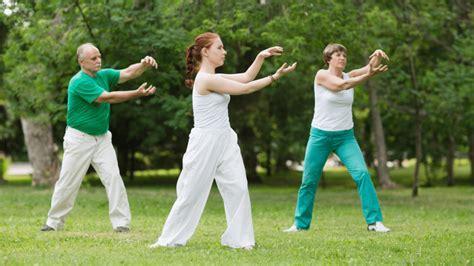
Tai chi exercise is characterized by slow, purposeful movements, involving meditative breathing, mindfulness, and imagery. The slow, deliberate movements combined with focused breathing create a serene environment that’s perfect for dialing down stress levels – may be aa big win for blood pressure management. Tai chi is extremely gentle on the body, making it accessible to most people.
STUDY This prospective, single-blinded randomized clinical trial was conducted between July 25, 2019, and January 24, 2022, at 2 tertiary public hospitals in China. Participants included 342 adults aged 18 to 65 years with prehypertension.
Participants were randomized in a 1:1 ratio to a Tai Chi group (n = 173) or an aerobic exercise group (n = 169). Both groups performed four 60-minute supervised sessions per week for 12 months.
Patients in both groups underwent a 12-month Tai Chi or aerobic exercise training program 4 times weekly. In both groups, each session consisted of a 10-minute warm-up, 40 minutes of core exercises, and a 10-minute cool-down activity. The 24-form Yang-style Tai Chi, consisting of 24 standard movements, was adopted for the Tai Chi intervention. Aerobic exercise interventions included climbing stairs, jogging, brisk walking, and cycling.
RESULTS A total of 342n participants (mean age, 49 years; 166 men [48%) were randomized to 1 of 2 intervention groups: 173 to Tai Chi and 169 to aerobic exercise.
At 12 months, the change in office SBP was significantly different between groups by −2.40 with a mean change of −7.0 mm Hg in the Tai Chi group vs −4.6 mm Hg in the aerobic exercise group.
Additionally, 24-hour ambulatory SBP (−2.2 mm Hg) and nighttime ambulatory SBP (−4.1 mm Hg) were significantly reduced in the Tai Chi group compared with the aerobic exercise group.
CONCLUSIONS In this study including patients with prehypertension, a 12-month Tai Chi intervention was more effective than aerobic exercise in reducing SBP. These findings suggest that Tai Chi may help promote the prevention of cardiovascular disease in populations with prehypertension.
One of the researchers said “The study’s findings indicating that tai chi was more effective than aerobic exercise in reducing [systolic blood pressure] among individuals with prehypertension offer valuable insights for healthcare providers and patients alike. Tai chi, as a mind-body exercise, may offer unique benefits beyond traditional aerobic activities, such as stress reduction, improved relaxation, and enhanced mental focus, which could contribute to its superior efficacy in lowering blood pressure.”
There are many health benefits of tai chi, which include decreasing stress, boosting mood, and promoting heart health, all of which can help with hypertension.
Other ways to lower blood pressure include working out on a regular basis and eating a healthy diet rich in fruits, vegetables, and whole grains.

